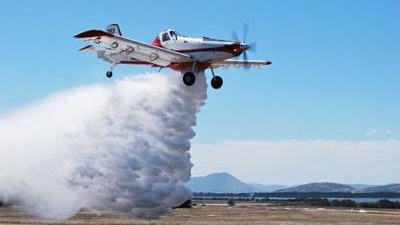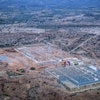
Air Tractor produces a range of agricultural aircraft that have been used in firefighting missions, such as spraying retardants in challenging terrains.
Stephen Holding, the general manager of Field Air, an Australian dealer and operator of the aircraft, says the Air Tractor is generally used on the continent for agricultural applications such as spreading fertilizer on large cropping areas, but this capability also makes it a good choice as a single-engine air tanker for firefighting.
Holding says because the Air Tractor needs to carry a huge load, it has a high power-to-weight ratio. The aircraft, for example, has a maximum take-off weight of 16,000lb (7,257kg). “An AT802 can carry approximately 3,000 liters of fire retardant,” said Holding.
When retardant is dropped on vegetation, it can last for a couple of weeks. It dries on the vegetation, forming a layer that retards the progress of a fire, says Holding, adding that retardant is more effective than foam concentrate or water gel, some of the other liquids that Air Tractors use to combat fires.
Australia is the driest inhabited continent on earth. The country experiences ferocious wildfires in summer when temperatures often exceed 40 degrees Celsius (104 degrees Fahrenheit).
“Air Tractors have two main fire-fighting roles,” said Holding. “The first is fighting the fires directly on the frontline. The latter role is known as ‘retardant line building’, where the Air Tractors work ahead of the fire to build up defensive lines and fire suppressants around strategic assets.”
He said Air Tractor has a computerized fire-door allowing the pilot to select how much retardant to drop and how big of an area to cover, an extremely important capability for aerial firefighting.
Another advantage of an Air Tractor is its deployment speed and adaptability, Holding noted.
“Compared to large air tankers, the smaller-sized Air Tractor can be deployed faster. Since it is originally an agricultural aircraft, Air Tractors can operate across various types of terrain, such as grass, field, gravel and fly from air strips and runways of around 800m length, which makes it perfect for manoeuvring at the scene of a fire,” Holding said.
The largest model of Air Tractor is the AT-802, of which there are approximately 100 in Australia, says Holding. The variant designed for firefighting is the 802AF or 802F. The ‘F’ variant also includes an amphibious version, the AT-802F Fire Boss that is fitted with Wipaire floats. There are 12 Fire Boss amphibious aircraft in Australia, according to Holding.
“The AT-802’s wing tanks can hold up to a maximum of 1,476 litres of jet fuel and burns up to 300 to 350 litres per hour depending on various factors like altitude and speed,” he added.
Due to its heritage as an agricultural aircraft, Air Tractor is designed to work in hot, dusty and tough environments; but the aircraft also needs a resilient engine to back it up, which is where Pratt and Whitney Canada’s PT6A-67AG and F engine comes into play. About half the AT-802s in Australia are fitted with the AG engine and the rest with the F, said Holding.
“Many firefighting operators these days with the AG-equipped AT-802 have started to upgrade this engine to the PT6A-67F variant, which has more power and more load carrying capacity.”
He said while Air Tractors play a role, it is only one tool of the fire agencies, and other aircraft such as helicopters and large aerial tankers are also needed.
He also said aerial fire fighters are there to help the teams fighting the fires on the ground. “We are part of an overall strategy and aerial firefighting is about aiding the resources on the ground.”






















